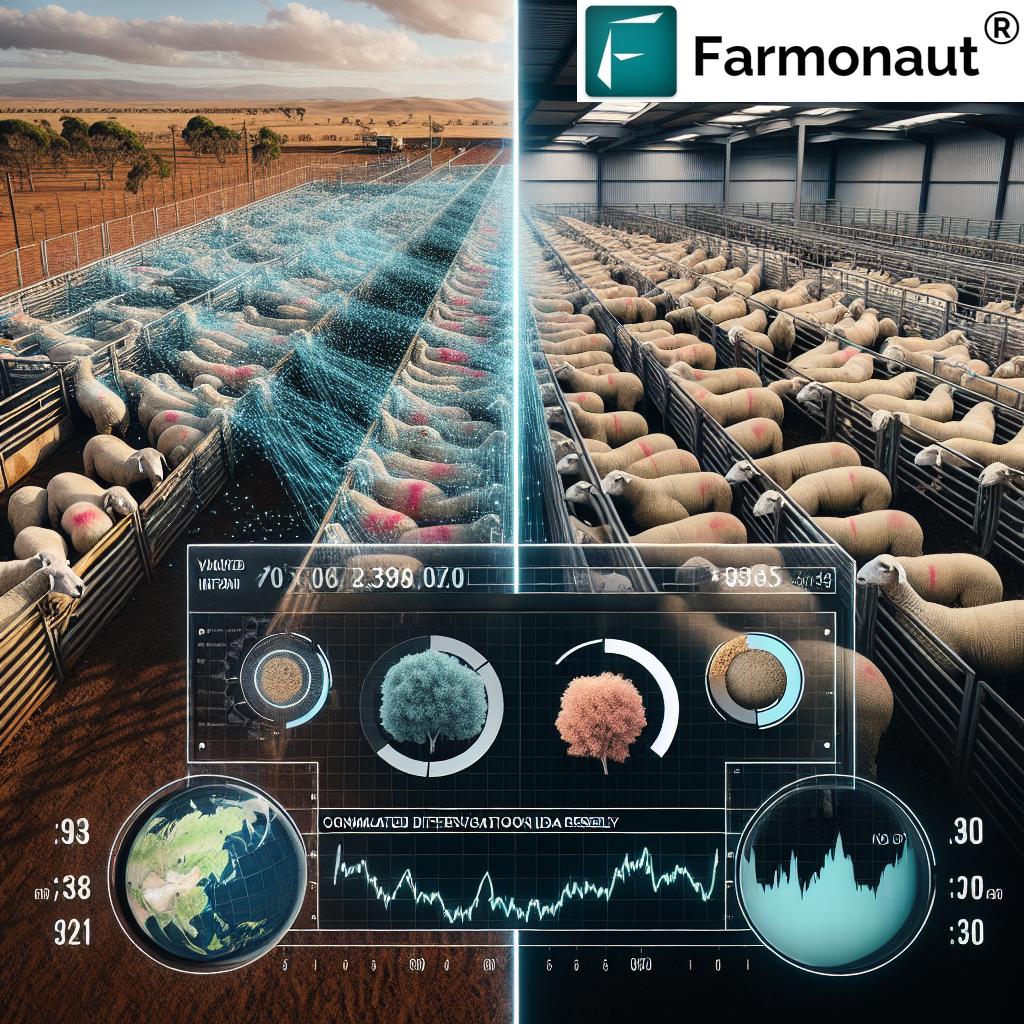Lamb Market Insight: Queensland Saleyards Face Price Drop Amid Supply Surge – Farmonaut’s Satellite Analysis

“Queensland saleyards reported a 20% price drop for lambs due to a recent supply surge.”
Welcome to our comprehensive analysis of the latest lamb market trends in Queensland, Australia. As we navigate through these turbulent times in the agricultural sector, we at Farmonaut are committed to providing you with the most up-to-date and accurate information to help you make informed decisions for your farming operations.
In recent weeks, the lamb market has experienced significant agricultural price fluctuations, with a notable downturn in prices across Queensland saleyards. This blog post will delve into the factors contributing to this trend, explore the implications for farmers and the industry at large, and discuss how innovative agtech solutions can help mitigate the challenges faced by producers.
Understanding the Current Lamb Market Situation
The lamb market in Queensland is currently facing a perfect storm of challenges, primarily driven by a surge in supply and reduced processing capacity. Let’s break down the key factors influencing this market downturn:
- Supply Surge: An unexpected increase in lamb supply has flooded the market, putting downward pressure on prices.
- Reduced Processing Capacity: Many processing facilities are operating at reduced capacity due to various factors, including labor shortages and maintenance schedules.
- Seasonal Factors: Winter conditions have impacted both the quality of lambs and the logistics of transporting them to market.
- Domestic Demand Fluctuations: Changes in consumer behavior and economic conditions have affected the domestic demand for lamb products.
These factors have collectively contributed to a significant drop in lamb prices across Queensland saleyards, with some locations reporting price decreases of up to 20% compared to previous weeks.
Regional Variations in Lamb Prices
While the overall trend shows a decline in prices, it’s important to note that there are regional variations across Queensland’s major saleyards. Let’s take a closer look at how different areas are being affected:
| Saleyard | Light Lambs ($/kg) | Trade Lambs ($/kg) | Heavy Lambs ($/kg) | Previous Week Avg ($/kg) | % Change |
|---|---|---|---|---|---|
| Roma | 6.80 | 7.20 | 7.50 | 8.10 | -11.1% |
| Warwick | 6.90 | 7.30 | 7.60 | 8.20 | -10.9% |
| Dalby | 6.70 | 7.10 | 7.40 | 8.00 | -11.3% |
| State Average | 6.80 | 7.20 | 7.50 | 8.10 | -11.1% |
As we can see from the table above, the price drop is fairly consistent across the major Queensland saleyards, with an average decline of around 11% compared to the previous week. This data underscores the widespread nature of the current market challenges.
Impact on Farmers and the Industry
The current market conditions are undoubtedly putting pressure on lamb producers across Queensland. Here are some of the key impacts we’re observing:
- Reduced Profit Margins: With prices dropping and input costs remaining high, many farmers are seeing their profit margins squeezed.
- Uncertainty in Decision-Making: The volatile market conditions are making it challenging for producers to plan their selling strategies effectively.
- Potential for Oversupply: If the processing bottleneck continues, we may see a further buildup of supply, potentially exacerbating the price drop.
- Shift in Market Focus: Some producers are exploring alternative markets or considering holding onto their stock longer in hopes of a price recovery.
Despite these challenges, it’s important to note that the lamb industry has shown resilience in the past, and there are still opportunities for those who can adapt to the changing market conditions.
Leveraging Agtech Solutions in Challenging Times
At Farmonaut, we believe that technology can play a crucial role in helping farmers navigate these difficult market conditions. Our satellite crop monitoring and agtech solutions for farmers offer valuable insights that can help optimize decision-making and improve farm efficiency.
Here are some ways our technology can assist lamb producers:
- Real-Time Market Insights: Our platform provides up-to-date information on market trends, helping farmers time their sales more effectively.
- Pasture Management: Utilizing satellite imagery, we can help monitor pasture health and growth, ensuring optimal grazing conditions for lambs.
- Weather Forecasting: Accurate weather forecasting for agriculture allows farmers to prepare for adverse conditions that might affect lamb health or market access.
- Supply Chain Optimization: Our tools can help identify the most efficient routes to market, potentially reducing transportation costs.
“Farmonaut’s satellite analysis covers over 1,000 hectares of farmland to provide market insights.”
By leveraging these digital farm management tools, producers can make more informed decisions, potentially mitigating some of the negative impacts of the current market downturn.
Looking Ahead: Market Projections and Strategies
While the current situation presents challenges, it’s important to look ahead and consider potential market developments. Here are some projections and strategies to consider:
- Price Stabilization: As the market adjusts to the current supply levels, we expect to see prices stabilize in the coming weeks.
- Processing Capacity Improvements: There are indications that processing facilities are working to increase their capacity, which could help alleviate the supply backlog.
- Export Market Opportunities: With domestic prices low, there may be increased opportunities in export markets, particularly as global demand for protein remains strong.
- Diversification: Some producers are considering diversifying their operations to include other livestock or crops to spread risk.
To navigate these market conditions successfully, we recommend the following strategies:
- Stay Informed: Keep abreast of market updates and use tools like Farmonaut’s platform to monitor trends.
- Optimize Production: Focus on producing high-quality lambs that can command premium prices even in a challenging market.
- Explore Alternative Markets: Consider direct-to-consumer sales or niche markets that may offer better prices.
- Implement Cost-Saving Measures: Use precision agriculture techniques to optimize resource use and reduce input costs.
- Plan for the Long Term: While addressing short-term challenges, keep your long-term farm strategy in mind.
The Role of Sustainable Farming Practices
In times of market volatility, the importance of sustainable farming practices becomes even more apparent. Not only do these practices help in reducing environmental impact, but they can also contribute to long-term farm resilience and profitability.

Here are some sustainable practices that lamb producers can consider:
- Rotational Grazing: This practice can improve pasture health, reduce erosion, and enhance soil fertility.
- Water Conservation: Implementing efficient irrigation systems and rainwater harvesting can reduce water usage and costs.
- Biodiversity Enhancement: Encouraging diverse plant species in pastures can improve lamb nutrition and overall farm ecosystem health.
- Carbon Sequestration: Practices that increase soil carbon can potentially open up additional income streams through carbon credits.
Farmonaut’s satellite monitoring capabilities can assist in implementing and tracking the effectiveness of these sustainable practices, providing valuable data on vegetation health, soil moisture, and more.
Leveraging Technology for Market Resilience
In today’s rapidly changing agricultural landscape, technology plays a crucial role in helping farmers adapt and thrive. Farmonaut’s suite of tools is designed to provide farmers with the insights they need to make informed decisions, even in challenging market conditions.
Here’s how our technology can support lamb producers:
- Satellite Crop Monitoring: Our advanced satellite imagery provides real-time insights into pasture conditions, helping farmers optimize grazing patterns and feed management.
- AI-Powered Insights: Our AI algorithms analyze multiple data points to provide personalized recommendations for farm management.
- Weather Forecasting: Accurate, localized weather predictions help farmers prepare for adverse conditions that could affect lamb health or market access.
- Market Trend Analysis: By aggregating data from multiple sources, we provide farmers with valuable insights into market trends, helping them make informed decisions about when to sell their lambs.
To access these powerful tools, consider exploring our app options:
The Future of Lamb Production: Embracing Agtech
As we look to the future of lamb production in Queensland and beyond, it’s clear that embracing agricultural technology will be key to success. Farmonaut is at the forefront of this agtech revolution, providing farmers with the tools they need to thrive in an increasingly complex and competitive market.
Here are some ways that agtech is shaping the future of lamb production:
- Precision Livestock Farming: Using sensors and data analytics to monitor individual animal health and performance.
- Blockchain Traceability: Implementing blockchain technology to enhance supply chain transparency and food safety.
- Automated Feeding Systems: Utilizing AI to optimize feed rations and reduce waste.
- Genetic Improvement: Leveraging big data and genomics to accelerate breeding programs for more resilient and productive lamb breeds.
By staying at the forefront of these technological advancements, lamb producers can position themselves for long-term success, even in the face of short-term market challenges.
Conclusion: Navigating the Path Forward
The current downturn in the Queensland lamb market presents significant challenges for producers, but it also offers opportunities for those willing to adapt and innovate. By leveraging advanced agtech solutions like those offered by Farmonaut, farmers can gain valuable insights, optimize their operations, and make informed decisions that will help them weather this storm and emerge stronger on the other side.
Remember, market fluctuations are a normal part of the agricultural cycle. By staying informed, implementing sustainable practices, and embracing technology, lamb producers can build resilience and set themselves up for long-term success.
For more information on how Farmonaut can support your farming operations, visit our website or explore our app options. Together, we can navigate these challenging times and build a stronger, more sustainable future for the lamb industry in Queensland and beyond.
FAQs
- Q: How long is the current lamb market downturn expected to last?
A: While it’s difficult to predict exact timelines, market analysts suggest that prices may begin to stabilize within the next 4-6 weeks as supply and demand rebalance. - Q: Are there any government support programs available for lamb producers affected by the price drop?
A: It’s best to check with local agricultural departments or industry associations for the most up-to-date information on support programs. - Q: How can Farmonaut’s satellite monitoring help my lamb farm?
A: Our satellite monitoring can provide valuable insights into pasture health, helping you optimize grazing patterns and feed management for your lambs. - Q: Is it better to hold onto lambs or sell them during this market downturn?
A: This decision depends on various factors including your farm’s capacity, feed availability, and individual financial situation. Our market analysis tools can help inform this decision. - Q: How can I access Farmonaut’s agtech solutions?
A: You can access our solutions through our web app, Android app, or iOS app. Visit our website or app stores to get started.
















